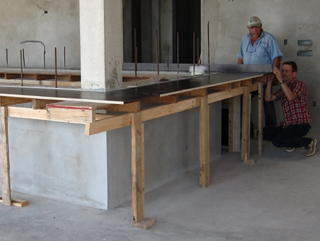“Is it necessary to have plywood tops on cabinets?”
The answer to this question really depends on whether the concrete countertops are being cast in place or if they are precast.
If they are cast in place, then the answer is yes. The plywood for cast in place concrete countertops is a permanent portion of the formwork. The plywood simply serves only as a form bottom, to keep concrete out of the cabinets, and it ceases being necessary once the concrete cures.
Note that you do need to protect the plywood with a moisture-proof barrier, or it will swell. You could also use a sheet good other than plywood that is already moisture-proof.

Precast concrete countertops do not require installing plywood on top of open cabinets. However, plywood does make installing large, awkward or heavy pieces easier, since the slab can be slid along the smooth top without catching on a cabinet wall.
Whether precast or cast in place, properly designed and fabricated concrete countertops are structural beams fully capable of supporting well over 300 lbs once installed (even 1.5” thick countertops). They don’t need the plywood at all. Plywood of any practial thickness (including ¾” material) is far more flexible than the concrete placed above it, and thus provides little or no structural support. Plywood should never be relied upon as the structural support for an improperly reinforced countertop.
To understand this further, note that plywood actually has higher flexural strength than concrete, so it does seem like it would help. However, plywood is also much more flexible than concrete. There’s a difference between flexural strength and flexibility. Placing a weaker and more brittle material on top of a stronger but more flexible material is akin to putting a sheet of glass on a trampoline and expecting the glass to withstand someone standing on it. That’s an extreme example, but you get the idea.
